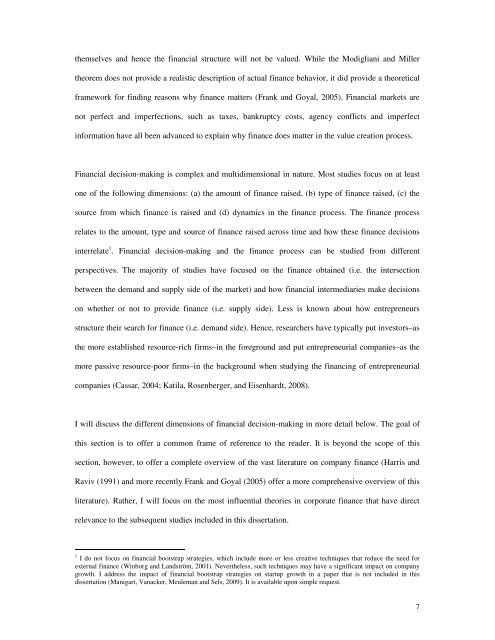Financing Unquoted High-Growth Companies: From Extending
Financing Unquoted High-Growth Companies: From Extending
Financing Unquoted High-Growth Companies: From Extending
You also want an ePaper? Increase the reach of your titles
YUMPU automatically turns print PDFs into web optimized ePapers that Google loves.
themselves and hence the financial structure will not be valued. While the Modigliani and Miller<br />
theorem does not provide a realistic description of actual finance behavior, it did provide a theoretical<br />
framework for finding reasons why finance matters (Frank and Goyal, 2005). Financial markets are<br />
not perfect and imperfections, such as taxes, bankruptcy costs, agency conflicts and imperfect<br />
information have all been advanced to explain why finance does matter in the value creation process.<br />
Financial decision-making is complex and multidimensional in nature. Most studies focus on at least<br />
one of the following dimensions: (a) the amount of finance raised, (b) type of finance raised, (c) the<br />
source from which finance is raised and (d) dynamics in the finance process. The finance process<br />
relates to the amount, type and source of finance raised across time and how these finance decisions<br />
interrelate 1 . Financial decision-making and the finance process can be studied from different<br />
perspectives. The majority of studies have focused on the finance obtained (i.e. the intersection<br />
between the demand and supply side of the market) and how financial intermediaries make decisions<br />
on whether or not to provide finance (i.e. supply side). Less is known about how entrepreneurs<br />
structure their search for finance (i.e. demand side). Hence, researchers have typically put investors–as<br />
the more established resource-rich firms–in the foreground and put entrepreneurial companies–as the<br />
more passive resource-poor firms–in the background when studying the financing of entrepreneurial<br />
companies (Cassar, 2004; Katila, Rosenberger, and Eisenhardt, 2008).<br />
I will discuss the different dimensions of financial decision-making in more detail below. The goal of<br />
this section is to offer a common frame of reference to the reader. It is beyond the scope of this<br />
section, however, to offer a complete overview of the vast literature on company finance (Harris and<br />
Raviv (1991) and more recently Frank and Goyal (2005) offer a more comprehensive overview of this<br />
literature). Rather, I will focus on the most influential theories in corporate finance that have direct<br />
relevance to the subsequent studies included in this dissertation.<br />
1 I do not focus on financial bootstrap strategies, which include more or less creative techniques that reduce the need for<br />
external finance (Winborg and Landström, 2001). Nevertheless, such techniques may have a significant impact on company<br />
growth. I address the impact of financial bootstrap strategies on startup growth in a paper that is not included in this<br />
dissertation (Manigart, Vanacker, Meuleman and Sels, 2009). It is available upon simple request.<br />
7

















